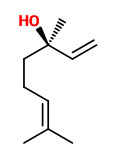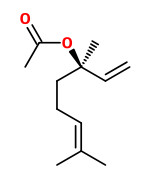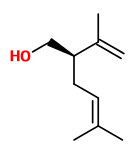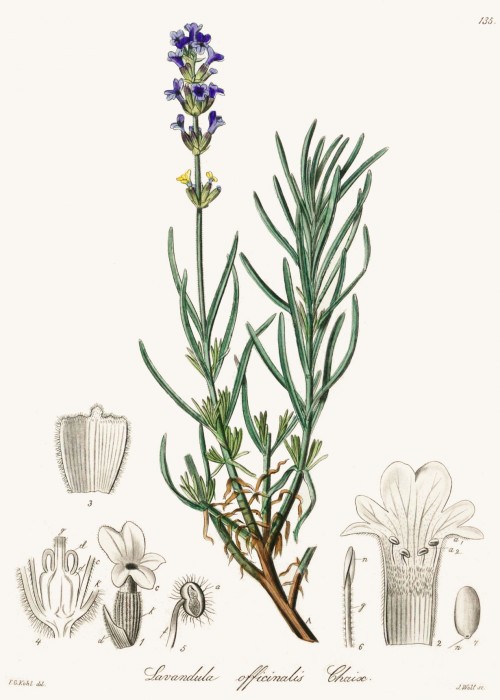Dies ist eine alte Version des Dokuments!
Lavandula angustifolia Mill. - syn. Lavandula officinalis Chaix - Lamiaceae
common lavender, English lavender, Echter Lavendel
Evergreen shrub, 0.20-1m high, native to Southwest Europe, cultivated and naturalized in Europa and Africa; leaves linear; flowers blue-violet.
„The lavender oil produced by supercritical extraction was compared to the oil obtained by hydrodistillation. The major difference between the two products was reflected in the linalyl acetate content. This compound was found to be 34.7% of the oil produced by supercritical fluid extraction and 12.1% of the hydrodistilled product. This difference can be ascribed to the hydrolysis of part of this compound during hydrodistillation.“
[Supercritical CO2 extraction and fractionation of lavender essential oil and waxes., Reverchon, E., Porta, G. D., Senatore, F., Journal of Agricultural and Food Chemistry, Vol.43(6), 1995, 1654-1658]
L.angustifolia oils and suprafluid extracts contained (R)-(-)-linalool and (R)-linalyl acetate with high enantiomeric excess (> 95%). A commercial sample indicated 20% adulteration.
[Enantiomeric distribution studies of linalool and linalyl acetate. A powerful tool for authenticity control of essential oils., Casabianca, H., Graff, J.B., Faugier, V., Fleig, F., Grenier, C., Journal of high resolution chromatography, 21(2), 1998, 107-112]
 (R)-(-)-linalool |  (R)-(-)-linalyl acetate |  (R)-(-)-lavandulol |
„Lavandin cultivars (Lavandula x intermedia Emeric ex Loisel.) produced significantly higher oil yield (7.1-9.9% dry inflorescences) compared to six lavender cultivars (2.8-5.0% dry inflorescences)… Lavender (Lavandula angustifolia Mill.) ‘Grey Lady’ produced the highest oil yield (5.0%), and ‘Lady’ the least (2.8%)… Lavender flowers from ‘Hidcote,’ ‘Munstead’ and ‘English’ were acceptable for the dried floral market. By year two, lavender cultivars reached full bloom and could be harvested for oil prior to the lavandins. Lavandin ‘Grosso’ oil possessed the highest camphor (8.1 as relative % of total oil). Enantiomeric distribution of (R)-(-) and (S)-(+) forms of linalool and linalyl acetate were found to be useful indicators of the purity of lavender oils.“ [Essential oil quantity and composition from 10 cultivars of organically grown lavender and lavandin., Renaud, E. N., Charles, D. J., Simon, J. E., Journal of Essential Oil Research, Vol.13(4), 2001, 269-273]
„Nine samples of lavender essential oil were analysed by GC-MS using low-polarity and polar capillary columns… Acceptable ranges for the major components of L.angustifolia essential oil according to ISO Standard 3515 are as follows: 1,8-cineole 0-15%, limonene 0-0.5%, trans-β-ocimene 2-6%, cis-β-ocimene 4-10%, 3-octanone 0-2%, camphor 0-0.5%, linalool 25-38%, linalyl acetate 25-45%, terpinen-4-ol 2-6%, lavandulol minimum 0.3%, lavandulyl acetate minimum 2.0%, α-terpineol 0-1%. Thus samples 2, 3 and 6 fit closest to the ISO standard, and sample 9 is also close but has a higher percentage of camphor. Most of the samples contain higher levels of limonene and α-terpineol than is stated in the ISO standard.“
[Characterisation of lavender essential oils by using gas chromatography-mass spectrometry with correlation of linear retention indices and comparison with comprehensive two-dimensional gas chromatography., Shellie, R., Mondello, L., Marriott, P., Dugo, G., Journal of Chromatography A, Vol.970(1), 2002, 225-234] http://jonnsaromatherapy.com/pdf/GC-MS_Lavandula_officinalis_2000_01.pdf
Linalool (40.9%) and linalyl acetate (33.9%) were quantitatively the main components in lavender oil. Linalool was found almost optically pure (88.0% ee; jasmine tea 82.6%) as (R)-(-). „Only (R)-(−)-linalool elicited a significant decrease in heart rate (P < 0.05) and an increase in high-frequency component in comparison with the controls, and produced calm and vigorous mood states.“
[Sedative effects of the jasmine tea odor and (R)-(−)-linalool, one of its major odor components, on autonomic nerve activity and mood states., Kuroda, K., Inoue, N., Ito, Y., Kubota, K., Sugimoto, A., Kakuda, T., Fushiki, T., European journal of applied physiology, 95(2-3), 2005, 107-114]
“… two monoterpene synthases (LaLIMS and LaLINS) and one sesquiterpene synthase (LaBERS) were cloned from lavender leaves and flowers. LaLIMS catalyzed the formation of (R)-(+)-limonene, terpinolene, (1R,5S)-(+)-camphene, (1R,5R)-(+)-α-pinene, β-myrcene and traces of α-phellandrene. The proportions of these products changed significantly when Mn2+ was supplied as the cofactor instead of Mg2+. The second enzyme LaLINS produced exclusively (R)-(−)-linalool, the main component of lavender essential oil. LaBERS transformed farnesyl diphosphate and represents the first reported trans-α-bergamotene synthase.„
[Cloning and functional characterization of three terpene synthases from lavender (Lavandula angustifolia)., Landmann, C., Fink, B., Festner, M., Dregus, M., Engel, K.H., Schwab, W., Archives of biochemistry and biophysics, 465(2), 2007, 417-429]
„The essential oil content in the inflorescence of lavender (Lavandula angustifolia Mill.) cultivated in the mid hills of Uttarakhand was found to be 2.8 % based on the fresh weight. The oil was analysed by capillary GC and GC-MS. Thirty seven constituents, representing 97.81 % of the oil were identified. The major components of the oil were linalyl acetate (47.56 %), linalool (28.06 %), lavandulyl acetate (4.34 %) and α-terpineol (3.75 %). The quality of lavender oil produced in India was found to be comparable to that produced in Hungary, France, China, Bulgaria, Russia and the USA.“
[Essential oil composition of Lavandula angustifolia Mill. cultivated in the mid hills of Uttarakhand, India., Verma, Ram S., et al., Journal of the Serbian Chemical Society Vol.75(3), 2010, 343-348]
“…we examined the effects of olfactory stimulation with scent of lavender oil (SLVO) in rats and observed that in contrast to grapefruit oil, it inhibits the sympathetic nerves innervating the white and brown adipose tissues and adrenal gland and excites the parasympathetic gastric nerve… Thus, scent of lavender oil and its active component, linalool, affect autonomic nerves, suppress lipolysis through a histaminergic response, and enhance appetite and body weight.„
[Olfactory stimulation with scent of lavender oil affects autonomic nerves, lipolysis and appetite in rats., Shen, J., Niijima, A., Tanida, M., Horii, Y., Maeda, K., Nagai, K., Neuroscience letters, Vol.383(1), 2005, 188-193]
“… olfactory stimulation with SLVO lowered renal sympathetic nerve activity (RSNA) and blood pressure (BP) and elevated GVNA in urethane-anesthetized rats.„
[Olfactory stimulation with scent of lavender oil affects autonomic neurotransmission and blood pressure in rats., Tanida, M., Niijima, A., Shen, J., Nakamura, T., Nagai, K., Neuroscience letters, Vol.398(1), 2006, 155-160]
„Anxiolytic effect of lavender was superior to placebo in 221 patients suffering from anxiety disorder. In addition, lavender improved associated symptoms such as restlessness, disturbed sleep, and somatic complaints and had a beneficial influence on general well-being and quality of life… the efficacy of a 6-week-intake of oral lavender oil preparation (Silexan, 80 mg/day), compared to lorazepam, was investigated in adults with generalized anxiety disorder. This study indicates that lavender effectively ameliorates generalized anxiety comparable to 0.5 mg/daily lorazepam.“
[Koulivand, Peir Hossein, Maryam Khaleghi Ghadiri, and Ali Gorji. „Lavender and the nervous system.“ Evidence-Based Complementary and Alternative Medicine 2013 (2013).] http://www.hindawi.com/journals/ecam/2013/681304/#B53
[A multi-center, double-blind, randomised study of the Lavender oil preparation Silexan in comparison to Lorazepam for generalized anxiety disorder., Woelk, H., Schläfke, S., Phytomedicine, 17(2), 2010, 94-99]
„One of the most common uses of lavender oils is in the enhancement of sleep. It has been demonstrated that lavender aromatics can improve sleep in the elderly and infants. Furthermore, exposure to lavender odors during sleep results in increased duration of deep slow-wave stage sleep. A therapeutic effect that is closely related to sleep is anxiety reduction, and many studies have evaluated the anxiolytic potential of lavender
essential oil. Tasev et al. related the sedative and relaxant effect of lavender oils with its effect on the central nervous system delivered via the olfactory system, and Tisserand suggested that L. angustifolia odors have a similar action to benzodiazepines in effecting gamma-aminobutyric acid (GABA) neurotransmission. A study on dental patients who were exposed to lavender scents showed significantly reduced anticipatory anxiety.
Many of the anxiolytic effects of lavender have been linked to the activity of linalool, and Hoferl et al. demonstrated that linalool fragrances alone reversed the psychological parameters produced by stress.“
[Biosynthesis and Therapeutic Properties of Lavandula Essential Oil Constituents., Woronuk, G., Demissie, Z., Rheault, M., Mahmoud, S., Planta Med, Vol.77, 2011, 7-15]

Lavandula angustifolia as Lavandula officinalis;
Kohl,F.G., Die officinellen Pflanzen der Pharmacopoea Germanica, t.135 (1891-1895)
